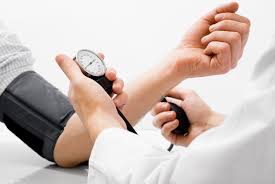All adults should have
their blood pressure checked routinely, If blood pressure is high, they need
the advice of a health worker.
For some people, lifestyle changes are sufficient to control blood pressure.
For others, these changes are insufficient and they need prescription
medication to control blood pressure.
Lifestyle measures:
Salt restriction - reducing salt intake to less than 5 g of salt per
day(typical salt intake is 9 -12 g per day)
Limit intake of alcohol.
High consumption of vegetables and
fruits and low-fat diet.
Reducing weight and maintaining it.
Regular physical exercise - hypertensive
patients should participate in at least 30 min of moderate-intensity dynamic
aerobic exercise (walking, jogging, cycling or swimming) on 5 to 7 days a week.
Stop Smoking and use of other tobacco products.
Dietary Approaches to Stop Hypertension (DASH)-The DASH eating plan requires no
special foods and instead provides daily and weekly nutritional goals. This
plan recommends:
Eating vegetables, fruits, and whole
grains.
Including fat-free or low-fat dairy
products, fish, poultry, beans, nuts, and vegetable oil
Limiting foods that are high in saturated fat, such as fatty meats, full-fat
dairy products, and tropical oils such as coconut, palm kernel, and palm oils.
Limiting sugar-sweetened beverages and
sweets.
When following the DASH eating plan, it is important to choose foods that are:
Low in saturated and trans fats
Rich in potassium, calcium, magnesium,
fiber, and protein
Lower in sodium
Antihypertensive Medicines- Antihypertensive drugs (drugs lowering the BP) work
in several ways, such as removing excess salt and fluid from the body, slowing
the heartbeat or relaxing and widening the blood vessels. Medicines to lower
blood pressure include:
Diuretics (Water or Fluid Pills): Flush excess sodium from the body, which
reduces the amount of fluid in blood and helps to lower your blood pressure.
Beta Blockers: Help heart to beat slower and with less force. As a result,
heart pumps less blood through blood vessels, which can help to lower blood
pressure.
Angiotensin-Converting Enzyme (ACE) Inhibitors: Angiotensin-II is a hormone
that narrows blood vessels, increasing blood pressure. ACE converts Angiotensin
I to Angiotensin II. ACE inhibitors block this process, which stops the
production of Angiotensin II, lowering blood pressure.
Angiotensin II Receptor Blockers (ARBs): Block angiotensin II hormone from
binding with receptors in the blood vessels. When angiotensin II is blocked,
the blood vessels do not constrict or narrow, which can lower your blood
pressure.
Calcium Channel Blockers: Keep calcium from entering the muscle cells of heart
and blood vessels. This allows blood vessels to relax, which can lower blood
pressure.
Alpha Blockers: Reduce nerve impulses that tighten blood vessels. This allows
blood to flow more freely, causing blood pressure to go down.
Alpha-Beta Blockers: Reduce nerve impulses and also slow the heartbeat. As a
result, blood pressure goes down.
Central Acting Agents: Act in the brain to decrease nerve signals that narrow
blood vessels, which can lower blood pressure.
Vasodilators: Relax the muscles in blood vessel walls, which can lower blood
pressure.



 Contact Us
Contact Us







 Hospitals
Hospitals
 Doctors
Doctors
 Diagnostic
Diagnostic
 Pharmacy
Pharmacy
 Health Tips
Health Tips
 Blog
Blog

























Comments